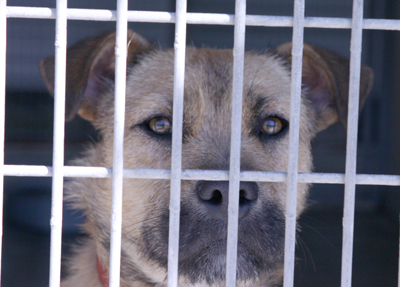Animal control manages rights of property and pet owners
When an employee at the Hollister Animal Shelter told Joann Hill
someone had called anonymously and asked if it would be legal to
trap Hill’s cat, she rushed home to her Hillcrest neighborhood to
look for her brown-and-gray tabby Mr. Nasty.
Animal control manages rights of property and pet owners
When an employee at the Hollister Animal Shelter told Joann Hill someone had called anonymously and asked if it would be legal to trap Hill’s cat, she rushed home to her Hillcrest neighborhood to look for her brown-and-gray tabby Mr. Nasty.
She found her scruffy cat, who has an orange nose, green eyes and long hair tufts coming out of his ears and put him in her garage away from possible cat traps. When a few days later a neighbor began circulating fliers about a lost cat named Jasper, Hill realized the trap meant for her pet might have inadvertently caught another neighborhood cat that looked very much like Mr. Nasty.
“I feel so helpless and I am willing to do anything to get [Jasper] back,” Hill said. “I feel it could have been my cat and just by luck of the draw it was her cat that went into the trap.”
The Hollister Animal Shelter is tasked with juggling the rights of property owners, pet owners and what is best for an animal in many cases.
In the case of cat trapping, it is legal in San Benito County neighborhoods, according to county and city ordinances, as long as the animal is turned over to the Hollister Animal Shelter. The shelter offers traps for rental to neighbors with feral or stray cat problems as well as misbehaved domestic cats.
No one in the neighborhood had talked to her about Mr. Nasty causing trouble in their yards, Hill said.
Mr. Nasty had been a fixture around the neighborhood for more than 11 years when he showed up and made himself at home in the yards of a couple neighbors. Hill and another neighbor take him for regular vaccines and even had him microchipped in case he went missing. The laws can seem contradictory since it is legal to have a cat on the loose, but also legal to trap said cat.
“There are no ordinances governing cats on the loose. We consider them free-roaming,” said Julie Carreiro, the Animal Control supervisor. “If it is doing damage to someone else’s property, that [property] owner has the right to bring it to the shelter. They don’t have the right to abandon it and that is considered a misdemeanor.”
Once a cat is trapped and surrendered to the animal shelter, staff will contact the owner if known, or if the pet has an identification tag or microchip.
The owners then can pick up the pet for a fee and staff will talk to them about options to curb bad behavior.
“They might want to keep it indoors or purchase a cat fencing system to keep them in their own backyard,” Carreiro said.
She suggested a Cat Fence-In system, a fencing system sold online that has worked for some cat owners.
Though the family missing Jasper checked at the shelter, he has not shown up and they have had no luck with neighborhood fliers.
Some neighbors who have speculated that Jasper may have been caught and dumped illegally can contact animal control and the department will investigate the situation.
Owners often come in looking for lost pets, but many of the animals that come into the shelter do not have identification. A pet on the loose can easily lose collar ids and nametags. The staff photographs animals for the Web site and runs a description of cats and dogs that are brought in once a week in a local newspaper.
“Most that come in don’t have anything, but microchips are getting to be more prominent,” Carreiro said. “When someone calls in and says we lost a gray tabby, do you know how many come in?”
Microchips have been used to identify pets lost across counties and time. Recently, the Hollister shelter had a cat come in that had a microchip ID. The cat had been missing for two years and belonged to people in Santa Rosa who reclaimed it.
The shelter has increased the length of time they hold pets to allow pet owners ample time to reclaim missing pets. Animals are held for at least 8 days before they are adopted out or taken by a rescue group.
“We work with rescue groups that come down about once a week,” Carreiro said.
The shelter handles more than 2,500 cats, dogs and other animals a year. Just under half of those animals are killed. The animals that are killed include feral cats and wild or injured animals.
While many of the animals that come in are found as strays or trapped by neighbors, still another group of animals are those surrendered directly by their owners. In the case of Margaret Baker, her dog was turned over to the shelter by a family member against her will while she was out of town for an extended time.
The shelter requires people show their driver’s license, but they have no way of knowing for sure that it is the actual owner who has brought a dog in.
“Some circumstances, unfortunately, are that people do really mean things sometimes,” Carreiro said.
That’s a reason the shelter has increased their holding period to eight days to allow pet owners more time to reclaim their pets.
The shelter helped reunite a local family Tuesday with their beagle Lady. Brandie Locke and her family received a call from the shelter that their dog had showed up at the shelter and the family hadn’t even realized she was missing yet. They believed she got out of their backyard by accident, but the identification the beagle had brought her back to her family.
For more information on local laws about pets or tips on finding missing pets, visit hollister.ca.gov and click on Animal Control.
Melissa Flores can be reached at mf*****@**********ws.com.










